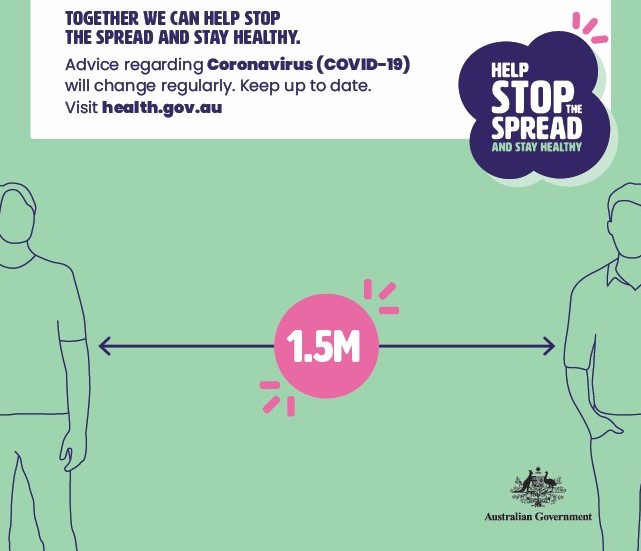Safe Work Australia (SWA) requires businesses to ensure their staff stay physically distant from each other by 1.5 meters, with 4 meters around them at all times. But for cleaning companies working across multiple sites, this can be pretty challenging.
So here are four ways you can ensure your cleaning team stays physically distant while they work. It is an extract from taken from the latest Guide to Cleaning for COVID-19.
The challenge of physical distancing while cleaning
Safe Work Australia’s information about physical distancing contains valuable guidelines for:
- Worker interactions and work tasks;
- Staff gatherings and training; and
- Travelling in a vehicle together for work purposes.
But much of SWA’s info is relevant to businesses operating from a fixed location. For cleaning companies offering essential services across multiple sites, meeting SWA’s physical distancing requirements can be quite challenging to control. For example:
- You cannot change the way a facility is laid out or the size of the cleaner’s room.
- Cleaning teams work across multiple sites, often with little supervision.
- Personnel need to travel to, from, and between different sites, often after hours.
- Cleaners may also work more than one job. This has been identified as one of the key ways coronavirus is spreading through the community in Victoria.
So here are 4 easy ways to make sure your teams are staying physically distant while cleaning.
1. Scheduling duties and breaks
The recent hotel quarantine breaches by security guards in Victoria, has shown just how easily COVID-19 infection can spread between workers, by taking breaks together, hugging in greeting, chatting in close proximity and sharing phones and other personal items.
Carefully plan your work schedules and workflows (order of tasks) so that cleaners do not need to work close together, or be in the cleaner’s room at the same time. If practical and safe to do so, stagger the arrival and departure times of cleaners. For example:
- One cleaner could be responsible for preparing all chemical bottles, carts and mop buckets ready for when other staff arrive (wear gloves to prevent contamination);
- One cleaner could wash cleaning cloths while others finish mopping or waste removal, then finish alone by disinfecting high touch points with disposable paper towel.
If physical distancing is not possible during breaks, or breaches are occurring, stagger break times as well so that workers do not take ‘smokos’ together.
2. Travelling to site
If workers need to travel in a vehicle together for work purposes, they still need to practice physical distancing.
Safe Work Australia has issued the following advice:
- Reduce the number of workers travelling together in a vehicle for work purposes.
- Ensure that only two people are in a 5 seat vehicle – the driver and a worker behind the front passenger seat. Only one worker should be in a single cab vehicle.
- If workers are required to travel together for longer than 15 minutes, set air conditioning to external airflow rather than to re-circulation or windows should be left opened.
- Clean shared vehicles more frequently, no matter the length of the trip, after each use.
SWA also advises that some States and Territories have placed strict limitations on gatherings in public places, meaning workers cannot travel together in a vehicle to and from work, or eat lunch together in a park for example. Check with your State work health and safety authority.
3. Training and meetings
Face to face training of cleaners is vitally important for demonstrating the correct use of cleaning, disinfection and putting on and removing PPE for example. To do this safely:
- Hold training sessions outdoors or in large spaces with adequate ventilation that enable workers to keep at least 1.5 metres apart from each other and the trainer.
- Ensure all trainers and trainees wear masks to prevent germs from being spread.
All other meetings should be conducted via electronic conferencing wherever possible.
4. Monitoring and support
Safe Work Australia has issued a range of free posters and resources to help remind workers about physical distancing and the risks of COVID-19 and measures to stop its spread. These posters should be put up in the cleaner’s room and can be used as part of tool-box training sessions.
We recommend that you nominate a ‘COVID-Safe Champion’ on every site, such as a team leader, who supports and reminds their team members to practice physical distancing.
The latest template we have developed to support the Guide to Cleaning for COVID-19 pack is called the COVID-Safe Cleaning Checklist.
This is a simple customisable Excel tool that your Champion can use to check that their team members are carrying out your physical distancing and hygiene practices correctly at all times.
Learn more about cleaning for COVID-19

This article is an extract from our comprehensive Guide to Cleaning for COVID-19. This Guide covers nearly everything you need to know about how to carry out coronavirus preventative and decontamination cleans. Learn how to comply with Government guidelines, keep your staff safe, and help your customers open back up for business safely.
When you buy this guide, you automatically receive free updates. Version 5 now contains 91 pages of fully referenced and science-based information, and is supported with a pack of 7 customisable and ready-to-use templates:
- Pandemic Risk Management Plan
- Procedure for Managing Cleaning Staff during Pandemics
- High Touch Point Cleaning Protocols
- SOP – Cleaning and Disinfecting on High Touch Points
- SOP – Coronavirus Decontamination Cleans
- COVID-Safe Cleaning Plan
- COVID-Safe Cleaning Checklist
Author, Bridget Gardner


